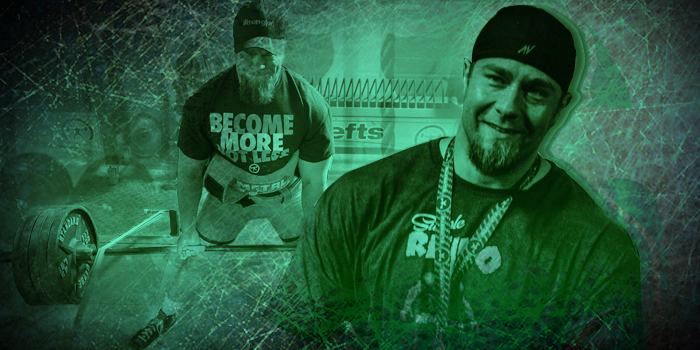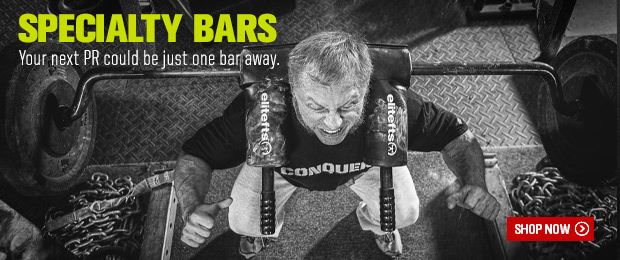
A stagnant lift can be extremely frustrating. The more advanced you become, the longer the stretches can be between records.
I was in that position when I boiled down my exercises that would make my deadlift climb again. Then 22 months, later I was up almost 100 pounds.
I want to give you a head start. These are seven exercises that, when built, will push up your sumo deadlift.
RECENT: Meet Attempt Considerations For Every Situation
1. Stiff Leg Sumo Deadlifts
The deadlift is a hamstring/hip movement while the back stays locked in. The stiff leg sumo deadlift will put those muscles to work. You will also start with the bar out in front of you due to the nature of the lift. Learn to flex the lats, pull the bar into you, and pull back.
As with the other exercises on this list, we are getting stronger in bad positions so that IF we end up there, we can recover.
2. Rackable Cambered Bar Good Mornings
Choosing this exercise was for the same reason as the stiff leg. It is hard on the hamstrings if you sit back into it, except we are using a close stance.
The Rackable Cambered Bar will also put major stress on the low back as the weight drifts away from you as you come down to the bottom.
I prefer sets of six and paired with Glute Ham Raises for 12 to 20 reps. When done properly it will likely bring you some hamstring cramps and a bigger deadlift.
For this workout, I decided to do 1 and 2:
3. Sumo Deadlift from 1-Inch Deficit
This was the first builder I used as a new lifter. It added about 100 pounds in my first year of competing. I would stand on 25-pound plates and perform sets of three to five. If you have hip issues, tread lightly. This will help build the start of your deadlift and blow through that sticking point three inches off the floor.
4. Suspended Good Mornings
This will be a general category, as there are many bars and heights to use. Start with the SS Yoke Bar set to the height of your hip crease.
If you watch videos of these being performed, watch how lifters rock back into the lift. You want to avoid rocking back. Set up and come right up.
The deadlift is from a dead stop, and unless you rock back that way when you deadlift, we want to avoid creating a stretch reflex on this exercise.
5. Front Squats to a Low Box
Front squats suck. If you’re using a box that is lower than parallel they, suck even more. The weight is out in front of you like a deadlift, and we want to keep upright. Choose these over SS Yoke Bar squats because you can’t keep going if you start to round like you can with the SS Yoke Bar. The SS Yoke Bar is a great option but holding the bar on your shoulders will lessen the load and if you break technique you will be forced to dump the bar. Use a wide stance, spread the floor, and think, “Deadlift.”
6. Deficit Deadlift (conventional)
The sumo deadlift is really about technique and finesse. If you are out of position, you won’t likely fight through it. The conventional deficit deadlift is a long fight to the finish. This is just as a much about the mental toughness as it is the muscular work. Learn to think while you are pulling and make corrections as needed.
7. Romanian Deadlifts
Romanian Deadlifts are a great way to work your hip extension while holding a good back position. If you are always doing things with a wide stance, you need to do some close stance, too.
Against bands or bar weight, these are great no matter what. Loading that stretch position can lead to major soreness.
These are great when you want to keep the load lower and can work as a substitute for dynamic effort deadlifts.
How to Use These Exercises
Not all of these exercises are for you. The key is to take these and find the two moneymakers.
Chose two and run them for 12 weeks and then test. Pair them with a wide and narrow stance. Keep it to one deadlift and pair it with a good morning or a squat.
As for sets and reps or for more information, I will defer to Dave Tate’s guide on supplemental movements. I like sets of five or six in most cases, but triples or higher reps above 10 are not out of questions.
This includes most of what I used to build my 800-pound deadlift. I peaked using isometrics but that is neither for the faint of heart nor the purpose of this article. Out of the other 40 weeks a year, these are the options I used to build my sumo deadlift.
The key to these exercises is choosing the assistance exercises to make this list move. Once you dial it all in, watch your progress skyrocket.










